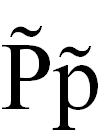P̃
In this article, we will explore the topic of P̃ in detail, analyzing its origins, evolution and relevance in today's society. Introducing readers to the history and context of P̃, we will delve into its many facets and dimensions, from its cultural impacts to its implications in daily life. Through a comprehensive approach, we will examine the different perspectives and opinions on P̃, providing a panoramic view that will allow us to understand its importance in the contemporary panorama. By the end of this reading, we hope that readers will have gained a more complete and enriched understanding of P̃, while also feeling motivated to reflect on its own meaning and relevance in their lives.
This article needs additional citations for verification. (January 2021) |
| P with tilde | |
|---|---|
| P̃ p̃ | |
 | |
| Usage | |
| Writing system | Latin script |
| Type | Alphabet |
| Language of origin | Yanesha |
| Phonetic usage | |
| Unicode codepoint | U+0050, U+0070, U+0303 |
| History | |
| Development |
|
| Other | |
P̃ (majuscule: P̃, minuscule: p̃) is a Latin P with a diacritical tilde. It is or was used as a grapheme in some languages of Vanuatu, such as North Efate, South Efate and Namakura, to represent a sound [k͡p]. It is also used in the Yanesha language.
The letter was introduced by missionaries and has been in use for over a hundred years.
In Bislama, the lingua franca of Vanuatu, p with tilde is called snekpi "snake-P".
In Old English, it was used as a contraction of the penny, as in ⋅cxx⋅ p̃. ("120 pence").
Computer encoding
Unicode encodes p with tilde with a combining diacritical mark (U+0303 ̃ COMBINING TILDE), rather than a precomposed character. As such, the tilde may not align properly with some fonts and systems. In standard HTML code: majuscule P̃, minuscule p̃. The Unicode HTML hex code is: minuscule p̃, majuscule P̃. The Unicode HTML decimal code is: minuscule p̃, majuscule P̃.
References
- ^ Thorpe, Benjamin (1840), "The Laws of King Edgar", Ancient Laws and Institutes of England; Comprising Laws enacted under the Anglo-Saxon Kings from Æthelbirht to Cnut, With an English Translation of the Saxon; The Laws called Edward the Confessor's; The Laws of William the Conqueror, and those ascribed to Henry the First: Also, Monumenta Ecclesiastica Anglicana, From the Seventh to the Tenth Century; And the Ancient Latin Version of the Anglo-Saxon Laws. With a Compendious Glossary, &c., London: Commissioners of the Public Records of the Kingdom, p. 113. (in Old English) & (in Latin) & (in English)